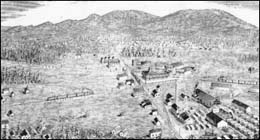Philip A. Woolley was a railroad developer from Elgin, Illinois, who moved to Washington just as the territory became a state in 1889. With the help of Territorial Attorney General James Bard Metcalfe, Woolley learned where three rail lines were projected to cross in a triangle a mile north of the Skagit River. Woolley and his sons built a sawmill near that point and then founded the company town of Woolley in 1890. Although Woolley and his town competed with the earlier town of Sedro about a half mile away, the two towns merged in 1898, with the new city of Sedro-Woolley centered on Woolley's old downtown blocks. After the merger, the Woolley family stayed in Washington, and Philip and his sons also established a new business in Savannah, Georgia, supplying rail ties and timber for the Seaboard Air Line.
East Coast Beginnings
Philip Woolley was born in Malone, New York, on February 17, 1831. His father was a physician and his ancestors had sided with the colonists in the Revolutionary War. His mother was a Canadian, and when Philip was in his early 20s he moved to Russell, Ontario -- about 40 miles southeast of Ottawa -- where he owned a general merchandise store while also felling timber on contract. He married Catherine Loucks of Ottawa on January 23, 1857, and they had three children while living in Canada.
During their last three years there, Woolley provided timber for railroad ties for a planned railroad in logging country south of the border in Michigan. That was the beginning of his lifetime work as a railroad contractor and developer. He moved his young family to Michigan in 1867, and he and Catherine had two more children while living near Grand Rapids over the next decade. The family then moved to Elgin, Illinois, 40 miles west of Chicago, where Woolley contracted for crossties and timbers for railroads, including the Chicago & Alton Railway, over the next dozen years.
Go West!
In the summer of 1889, Woolley discovered an opportunity to establish his contracting business in Washington Territory. The Northern Pacific Railroad had built westward toward a terminus at Tacoma to become the second truly transcontinental railroad, and only one short rail line existed north of the Columbia River. More than a dozen "paper railroads" were being promoted in anticipation of a boom in the Puget Sound region, and Woolley learned from Metcalfe that three routes would likely all cross just north of the Skagit River.
In November 1889, as Washington become a state, Philip and Catherine traveled west on the Canadian Pacific Railroad. As Catherine set up house in the little village of Sedro on November 29, Philip went to the Skagit County seat in Mount Vernon and arranged to buy 40 acres of land where the rail lines would cross. When his sons arrived, they all began building the Skagit River Lumber & Shingle Mill. After statehood, Metcalfe went back to private practice and the Woolley family was one of his principal clients.
The Fairhaven & Southern Railway was already laying track east of the mill, running on a diagonal from Bellingham Bay to Mortimer Cook's town of old Sedro. The second planned line, Seattle & Northern, was building eastward from Anacortes toward Sedro and would arrive in April 1890. The last line, the Seattle, Lake Shore & Eastern, was building north from Seattle and would arrive in the fall of 1890. Sure enough, all three crossed as Metcalfe predicted, forming a triangle that measured about 100 yards on each side.
Woolley's Townsite Wins Out
Although both old and new Sedro had a head start on Woolley's new company town, he had the considerable advantage of location. When fire and floodwaters threatened old Sedro by the Skagit River, the original businesses first moved to new Sedro and erected buildings on Jameson and on 3rd streets. After a major fire destroyed the Pioneer Block on 3rd Street and the three-story Hotel Sedro burned across the street, businesses began moving to Woolley's town, starting in 1895.
Progressive business leaders in both towns formed the Twin Cities Business League in 1896 and promoted consolidation of both towns and their redundant government offices that were just a half mile apart. Finally, in November 1898, the Skagit County commissioners called for naming petitions from both towns. When the vote came in at 81-76, favoring Sedro, the commissioners proposed a compromise with a hyphen between the names.
In December 1898, the merger was officially accepted. As Woolley's company town changed into an incorporated city, Woolley and his sons were already looking for new horizons. In 1901 they found a new major client, the Seaboard Air Line, which operated three railroads out of Savannah, Georgia. Over the next decade, Woolley supplied ties and railroad timbers for the company. Although his headquarters was in the south, Philip lived both in Georgia and in Sedro-Woolley. Philip died at his Woodworth Street mansion in Sedro-Woolley on June 12, 1912, and Catherine died there on March 28, 1924.

